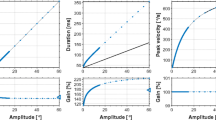Abstract
We compare model trajectories driven by different orders of controller signals to statistics on shapes of human saccadic eye movements. The commonly recorded dynamic overshoot must be driven by a multipulse controller signal, but multipulse controller signals need not always produce observable dynamic overshoots. Thus it is possible that a single strategy — multipulse control — produces all saccades, but that the strategy is not always apparent in the recorded movements.
Similar content being viewed by others
References
Bahill, A.T., Clark, M.R., Stark, L.: Dynamic overshoot in saccadic eye movements is caused by neurological control signal reversals. Exp. Neurol. 48, 107 (1975)
Bahill, A.T., Hsu, F.K., Stark, L.: Clissadic overshoots are due to pulse width errors. Arch. Neurol. 35, 138 (1978)
Clark, M.R., Stark, L.: Time optimal behavior of human saccadic eye movement. IEEE Trans. Autom. Control 20, 345 (1975)
Author information
Authors and Affiliations
Rights and permissions
About this article
Cite this article
Lehman, S.L., Stark, L.W. Multipulse controller signals. Biol. Cybern. 48, 9–10 (1983). https://doi.org/10.1007/BF00336879
Received:
Issue Date:
DOI: https://doi.org/10.1007/BF00336879




